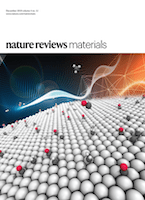
Nature Reviews Materials
Scope & Guideline
Transforming Ideas into Impactful Materials Solutions
Introduction
Aims and Scopes
- Materials Innovation and Design:
The journal focuses on the design of new materials and innovative processes, exploring how advancements in material science can lead to breakthroughs in technology and applications. - Sustainability and Environmental Impact:
There is a strong commitment to investigating sustainable materials and processes, addressing the environmental impact of material production and use, and promoting circular economy principles. - Interdisciplinary Approaches:
Nature Reviews Materials encourages interdisciplinary research, bridging fields such as chemistry, physics, engineering, and biology to enhance the understanding and application of materials. - Characterization and Performance Evaluation:
The journal emphasizes the importance of characterizing material properties and evaluating their performance in real-world applications to advance material science. - Emerging Technologies:
A consistent focus is placed on the role of emerging technologies, such as machine learning and artificial intelligence, in the development and optimization of materials.
Trending and Emerging
- High-Entropy Materials:
There is a growing interest in high-entropy materials, which offer unique properties and potential for a variety of applications in energy storage and electronics. - Sustainable and Biodegradable Materials:
Research on sustainable materials, including biodegradable polymers and eco-friendly composites, has surged as the need for environmentally responsible solutions becomes more urgent. - Nanotechnology and Nanomaterials:
Nanotechnology continues to be a significant focus, with advancements in nanomaterials for applications in medicine, energy, and electronic devices gaining traction. - Smart and Responsive Materials:
The development of smart materials that can respond to environmental stimuli, such as temperature or light, is increasingly prominent, reflecting their potential in various applications. - AI and Machine Learning Integration:
The integration of artificial intelligence and machine learning into materials science research is an emerging trend, facilitating the discovery and optimization of new materials.
Declining or Waning
- Traditional Inorganic Materials:
There has been a noticeable decrease in publications focused solely on traditional inorganic materials, such as ceramics and metals, as attention shifts towards more advanced composites and multifunctional materials. - Basic Theoretical Studies:
The journal has seen fewer articles dedicated to purely theoretical studies without experimental validation, as the demand for practical applications and experimental results grows. - Low-Impact Materials:
Research on low-impact materials that do not leverage new technologies or innovations has decreased, as the field increasingly prioritizes high-performance and sustainable solutions.
Similar Journals
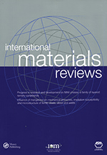
INTERNATIONAL MATERIALS REVIEWS
Your Gateway to Cutting-Edge Materials ReviewsINTERNATIONAL MATERIALS REVIEWS, published by SAGE Publications Inc, is a leading journal dedicated to the comprehensive analysis of contemporary research in the fields of materials chemistry, mechanical engineering, mechanics of materials, and the study of metals and alloys. With an impressive impact factor and a Q1 ranking across multiple categories such as Materials Chemistry and Mechanical Engineering in 2023, it ranks amongst the top journals for innovative materials research. The journal has a long-standing history since its inception in 1987 and continues to serve as a crucial resource for academics and professionals alike. Although it is not open access, it is renowned for its rigorous peer-review process and its commitment to disseminating high-quality materials science research globally. Researchers, students, and industry professionals benefit greatly from the journal's insightful reviews, both for the advancement of theoretical knowledge and practical applications within the fast-evolving materials field.

GIANT
Pioneering Research for a Sustainable Future.GIANT is a pioneering open-access journal published by Elsevier that has rapidly established itself as a cornerstone in the fields of Chemistry, Materials Chemistry, Polymers and Plastics, and Surfaces, Coatings and Films. Since its inception in 2020, GIANT has been committed to disseminating cutting-edge research and facilitating scholarly communication in these dynamic areas. With a remarkable Q1 ranking across multiple categories, the journal reflects an impressive impact factor within the academic community, evidenced by its standing in the top 82nd percentile in several Scopus classifications. Based in the Netherlands at Radarweg 29, Amsterdam, GIANT embraces a global audience through its open-access model, ensuring that groundbreaking discoveries are accessible to researchers, professionals, and students alike. Fostering innovation, the journal strives to shape the future of materials science and chemistry, making significant contributions in an era characterized by rapid scientific advancement.
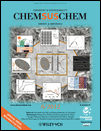
ChemSusChem
Pioneering Research for a Greener FutureChemSusChem is a premier interdisciplinary journal, published by WILEY-V C H VERLAG GMBH, that focuses on the critical fields of Chemical Engineering, Energy, Environmental Chemistry, and Materials Science. Since its inception in 2008, the journal has consistently maintained a Q1 ranking across multiple categories, highlighting its role as a vital resource for researchers and professionals dedicated to advancing sustainable chemical processes and technologies. With an impressive impact factor, it ranks 12th in General Chemical Engineering and is highly regarded within its scopes, indicating the journal's commitment to publishing high-quality, innovative research that addresses global challenges in energy and environmental sustainability. Though it operates on a subscription model, its contributions are essential for those in academia and industry seeking cutting-edge developments in sustainable chemistry. As it approaches its convergence span through 2024, ChemSusChem continues to shape the future of sustainable chemistry, making it a must-read for students, researchers, and practitioners alike.
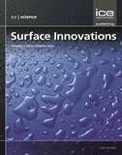
Surface Innovations
Innovating Tomorrow's Surface Technologies TodaySurface Innovations, an esteemed journal published by Emerald Group Publishing Ltd, serves as a crucial platform for researchers and professionals working within the fields of Materials Chemistry, Process Chemistry and Technology, and Surfaces, Coatings and Films. Launched in 2013, this journal has garnered attention for its commitment to advancing knowledge and innovation, holding a distinguished Q3 ranking in multiple categories as of 2023. With a focus on the latest methodologies and applications in surface science, Surface Innovations not only facilitates the dissemination of cutting-edge research but also encourages interdisciplinary collaboration among scientists and engineers. While not an open-access journal, it offers numerous options for accessibility to engage a wide array of audiences, making it a valuable resource for those looking to expand their understanding and expertise in this rapidly evolving field. The journal's consistent inclusion in high-ranking Scopus categories further underscores its academic impact and relevance.

ACS Materials Au
Empowering a Global Community of Materials InnovatorsACS Materials Au, published by the American Chemical Society, is a premier open-access journal that has been at the forefront of materials science since its inception in 2021. With an ISSN of 2694-2461, this journal encompasses an expansive range of topics including biomaterials, electronic, optical and magnetic materials, materials chemistry, and polymers and plastics, consistently achieving Q1 rankings in these categories for 2023. The journal is based in the United States and operates from the AMS's headquarters in Washington, DC, offering significant visibility and a robust platform for researchers. The journal's commitment to open access ensures wide dissemination of groundbreaking research, enabling a diverse audience—including researchers, professionals, and students—to engage with the latest advancements in materials science. With an encouraging impact factor and a focus on novel materials and innovative applications, ACS Materials Au stands as a vital resource for anyone devoted to understanding and advancing the frontiers of materials engineering and science.
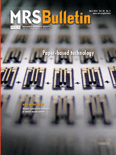
MRS BULLETIN
Championing High-Impact Research for Tomorrow's Innovations.MRS BULLETIN is a distinguished academic journal published by Springer Heidelberg, focusing on groundbreaking research in the fields of condensed matter physics, materials science, and theoretical chemistry. With an impressive impact factor and categorizations in the top quartile (Q1) for 2023, it ranks among the leading journals in its field, demonstrating its critical role in advancing scientific knowledge and innovation. Operating from Heidelberg, Germany, this journal serves as an essential platform for the dissemination of high-quality research, synthesizing pivotal findings and discussions that bridge academia and industry. Researchers, professionals, and students will find invaluable insights within its pages, showcasing developments that are vital for fostering innovation in materials and physical sciences. Although it is not an open access journal, its rigorous peer-review process ensures the highest standards of scholarly communication, securing its reputation as a premier resource for current trends and breakthroughs.
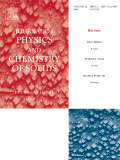
JOURNAL OF PHYSICS AND CHEMISTRY OF SOLIDS
Advancing the Frontiers of Solid-State ResearchJOURNAL OF PHYSICS AND CHEMISTRY OF SOLIDS, published by Pergamon-Elsevier Science Ltd, is a distinguished international journal that has been at the forefront of disseminating cutting-edge research in the fields of physics, chemistry, and materials science since its inception in 1956. This journal, which is recognized for its high impact in the Q2 category across multiple subjects—including Chemistry (miscellaneous), Condensed Matter Physics, and Materials Science—serves as a vital platform for researchers, professionals, and students to engage with significant advances in solid-state physics and chemistry. With Scopus rankings placing it in the top 15% of its field across various domains, the journal plays a crucial role in shaping the scientific dialogue surrounding materials properties, synthesis, and applications. Although it does not currently offer open access options, the presented research is widely recognized for its quality and relevance, ensuring that published works contribute meaningfully to ongoing scholarly discussions.
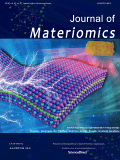
Journal of Materiomics
Leading Research in Surface Coatings and FilmsThe Journal of Materiomics, published by Elsevier, stands at the forefront of research in the interdisciplinary fields of materials science, particularly focusing on Electronic, Optical and Magnetic Materials, Metals and Alloys, and Surface Coatings and Films. Since its inception in 2015, this Open Access journal has fostered innovative research and theoretical advancements, facilitating the dissemination of knowledge with a global audience. With an impressive impact factor and consistently ranked in the top tiers of its categories — notably Q1 in 2023 for all its major focus areas, the journal positions itself as a vital resource for researchers, professionals, and students seeking to explore cutting-edge developments in materials science. Based in Amsterdam, Netherlands, the journal encourages the rigorous investigation of material interactions at the nanoscale, fostering advancements that underscore the applicability of materials across various industries. By providing a platform for high-quality research, the Journal of Materiomics plays a critical role in shaping the future of material technologies.

Advanced Powder Materials
Empowering Researchers with Open Access InsightsAdvanced Powder Materials, published by KEAI PUBLISHING LTD, stands at the forefront of research in materials science, particularly focusing on the intricate relationships within powder materials and their applications across several domains including catalysis, ceramics, energy, and coatings. With an Open Access policy initiated in 2022, this journal ensures that cutting-edge findings are readily accessible to researchers, professionals, and students globally. Based in Beijing, China, the journal has gained recognition for its exceptional impact, achieving a prestigious Q1 ranking in multiple categories such as Catalysis, Ceramics and Composites, and Materials Science. The journal not only promotes innovative research but also serves as a vital platform for interdisciplinary collaboration, significantly impacting the fields it covers, which also include notable rankings in Metals and Alloys and Surfaces, Coatings, and Films. By fostering an environment of knowledge sharing, Advanced Powder Materials is poised to make substantial contributions to the scientific community over its converged years from 2022 to 2024.

Tungsten
Fostering collaboration in the realm of tungsten innovation.Tungsten, published by SpringerNature, is a prestigious academic journal dedicated to advancing the field of materials science with a specific focus on tungsten and its diverse applications. Launched in 2019, the journal has quickly established itself as a leading resource in its domain, achieving a remarkable Q1 ranking across multiple categories including Materials Chemistry, Materials Science (miscellaneous), Metals and Alloys, and Surfaces, Coatings and Films. With robust performance reflected in its Scopus rankings—holding significant positions such as rank #20 in Metals and Alloys (88th percentile)—Tungsten serves as a vital platform for researchers and professionals seeking to disseminate innovative findings and foster collaboration in the materials science community. Although not an Open Access publication, this journal offers a well-curated collection of high-quality research articles, reviews, and technical notes aimed at driving forward the understanding and application of tungsten in various scientific sectors. Operating out of the United States, Tungsten is committed to providing an essential resource for academia and industry alike, making a significant contribution to the evolving landscape of materials research.